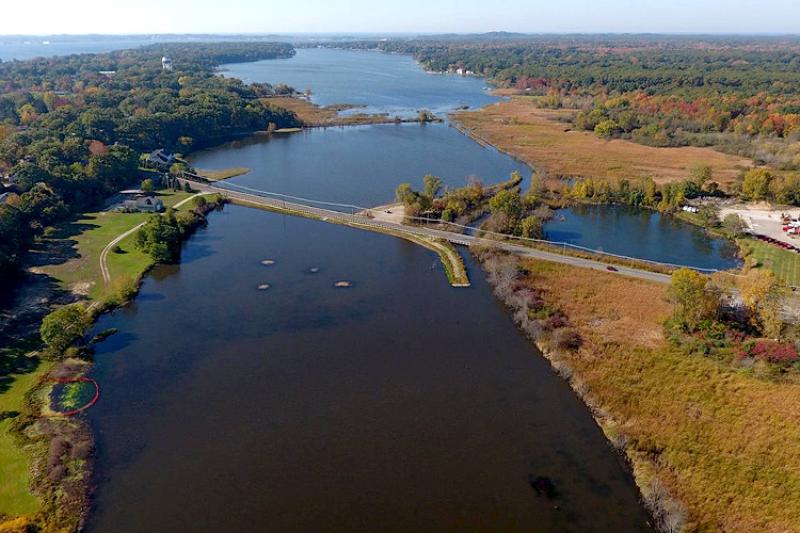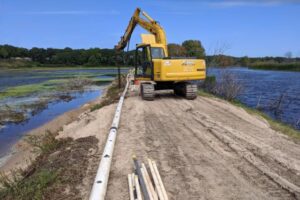For decades, Michigan’s Muskegon Lake was considered one of the most degraded areas in the Great Lakes region.
A 2011 study determined that, over 15 years, the 2009 American Recovery and Reinvestment Act funding NOAA invested in Muskegon Lake restoration would result in a 6-to-1 return on investment (ROI) to the local economy.
A 2020 follow-up study confirmed those projections, finding that habitat restoration in Muskegon Lake is improving area property values and boosting recreational opportunities for the surrounding community.
NOAA and the Great Lakes Commission have partnered since 2008 to restore habitat and improve water quality in the area.
With much of this work nearly finished, Muskegon Lake could soon be removed from the list of Great Lakes Areas of Concern.
In May of 2022, NOAA and other partners celebrated a significant milestone, in which all management actions necessary to remove the AOC designation are now complete.
History of Pollution
In the late 1800s, the city of Muskegon was home to many different industries, including lumber mills, chemical companies, foundries, a coal-fired power plant, and a paper mill.Over time, these industries filled in the shoreline of the lake and contaminated the water and sediment with compounds such as mercury and polycyclic aromatic hydrocarbons. This resulted in habitat loss and degradation, water quality concerns, and declines in fish and wildlife populations.
In 1987, Muskegon Lake was listed as a Great Lakes Area of Concern, one of 43 “toxic hot spots” in the United States and Canada.
Designation as an Area of Concern is based on a list of “beneficial use impairments.” These factors indicate how a waterway’s poor conditions are affecting the environment, human health, and the local economy.
Local, state, and federal partners work to restore an Area of Concern by addressing its impairments. Once all a waterway’s impairments have been addressed, its designation as an Area of Concern can be removed, a process known as “delisting.”
Comprehensive Restoration Efforts
NOAA works through the Great Lakes Restoration Initiative to implement habitat restoration throughout the Great Lakes region, including in Great Lakes Areas of Concern.
Through the initiative, NOAA has provided funding to the Great Lakes Commission to support several habitat restoration projects in the Muskegon Lake Area of Concern.
These projects, overseen by the West Michigan Shoreline Regional Development Commission, include:
- Veterans Memorial Park: Partners restored more than 15 acres of habitat and more than 6,000 feet of shoreline at this community memorial park. The work also included removing more than 40,200 metric tons of sediment and replacing an aging water control structure to allow for fish passage;
- Lower Muskegon River: Partners are working to remove three dikes from a former celery farm to help reconnect nearly 58 acres of wetland habitat with the Muskegon River;
- Muskegon Lake Nature Preserve: Work in progress at the Muskegon Environment, Research, and Education Society’s Muskegon Lake Nature Preserve will restore nearly 8 acres of wetland habitat;
- Former Amoco Site: Restoration underway at the former Amoco oil distribution terminal is expected to restore 9.8 acres of habitat and 575 feet of shoreline, and remove 1,700 feet of concrete wall surrounding the property;
- Heritage Landing: Strong storm events during record high Lake Michigan water levels led to damage and erosion at this site in 2017. Restoration and repair work improved habitat for fish and wildlife and will help prevent further erosion in the future;
- Bear Creek: This project reconnected more than 36 acres of coastal wetlands, improving water flow and fish passage to Muskegon Lake. Work also included removing roughly 120,000 cubic yards of sediment that contained harmful levels of phosphorus; and
- Mill Debris Removal: This project removed more than 300,600 metric tons of logging-era sawmill debris from four different sites in Muskegon Lake. Restored open water and lake bottom habitats are expected to benefit lake sturgeon and other aquatic life.
NOAA and the Great Lakes Commission are also supporting ecological monitoring for many of these projects, which is being conducted through the Grand Valley State University‘s Annis Water Resources Center.
In addition to our restoration work through the Great Lakes Restoration Initiative, NOAA selected Muskegon Lake as one of our ten Habitat Focus Areas. NOAA also invested $10 million into habitat restoration in Muskegon Lake through the 2009 American Recovery and Reinvestment Act.
Combined, NOAA’s many efforts in the Muskegon Lake region are helping to restore this important ecosystem and support Great Lakes fisheries and communities.
Photos courtesy of Muskegon Lake Watershed Partnership.


